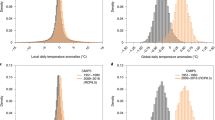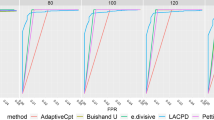Abstract
This paper introduces an original method for climate change detection, called temporal optimal detection method. The method consists in searching for a smooth temporal pattern in the observations. This pattern can be either the response of the climate system to a specific forcing or to a combination of forcings. Many characteristics of this new method are different from those of the classical “optimal fingerprint” method. It allows to infer the spatial distribution of the detected signal, without providing any spatial guess pattern. The spatial properties of the internal climate variability doesn’t need to be estimated either. The estimation of such quantities being very challenging at regional scale, the proposed method is particularly well-suited for such scale. The efficiency of the method is illustrated by applying it on real homogenized datasets of temperatures and precipitation over France. A multimodel detection is performed in both cases, using an ensemble of atmosphere-ocean general circulation models for estimating the temporal patterns. Regarding temperatures, new results are highlighted, especially by showing that a change is detected even after removing the uniform part of the warming. The sensitivity of the method is discussed in this case, relatively to the computation of the temporal patterns and to the choice of the model. The method also allows to detect a climate change signal in precipitation. This change impacts the spatial distribution of the precipitation more than the mean over the domain. The ability of the method to provide an estimate of the spatial distribution of the change following the prescribed temporal patterns is also illustrated.








Similar content being viewed by others
References
Allen M, Tett S (1999) Cheking for model consistency in optimal fingerprinting. Clim Dyn 15(6):419–434
Anderson T, Das Gupta S, Styan G (1972) A bibliography of multivariate statistical analysis, Halsted Press, Wiley
Caussinus H, Mestre O (2004) Detection and correction of artificial shifts in climate series. J R Stat Soc Ser C (Appl Stat) 53(3):405–425
Hasselmann K (1993) Optimal fingerprints for the detection of time-dependent climate change. J Clim 6(10):1957–1971
Hegerl G, Von Storch H, Santer B, Cubash U, Jones P (1996) Detecting greenhouse-gas-induced climate change with an optimal fingerprint method. J Clim 9(10):2281–2306
Hegerl G, Zwiers F, Braconnot P, Gillet N, Luo Y, Marengo Orsini J, Nicholls N, Penner J, Stott P (2007) Understanding and attributing climate change. In: Solomon S, Qin D, Manning M, Chen Z, Marquis M, Averyt KB, Tignor M, Miller HL (eds) Climate change 2007: the physical science basis. Contribution of Working Group I to the fourth assessment report of the Intergovernmental Panel on climate change. Cambridge University Press, Cambridge
IPCC (2007) Climate change 2007: The physical science basis. Contribution of Working Group I to the fourth assessment report of the Intergovernmental Panel on climate change. In: Solomon S, Qin D, Manning M, Chen Z, Marquis M, Averyt KB, Tignor M, Miller HL (eds) Cambridge University Press, Cambridge, p 996
Karoly D, Wu Q (2005) Detection of regional surface temperature trends. J Clim 18:4337–4343
Ribes A, Azaïs J, Planton S (2009) Adaptation of the optimal fingerprint method for climate change detection using a well-conditioned covariance matrix estimate. Clim Dyn 33(5):707–722. doi:10.1007/s00382-009-0561-4
Schneider T, Held I (2001) Discriminants of twentieth-century changes in earth surface temperatures. J Clim 14(3):249–254
Spagnoli B, Planton S, Déqué M, Mestre O, Moisselin JM (2002) Detecting climate change at the regional scale : the case of france. Geophys Res Lett 29(10):90–1–90–4
Stone D, Allen M (2005) Attribution of global surface warming without dynamical models. Geophys Res Lett 32:L18711. doi:10.1029/2005GL023682
Stone D, Allen M, Selten F, Kliphuis M, Stott P (2007) The detection and attribution of climate change using an ensemble of opportunity. J Clim 20(3):504–516
Stott P, Tett S, Jones G, Allen M, Ingram W, Mitchell J (2001) Attribution of twentieth century temperature change to natural and anthropogenic causes. Clim Dyn 17:1–21
Tett S, Stott P, Allen M, Ingram W, Mitchell J (1999) Causes of twentieth-century temperature change near the earth’s surface. Nature 399:569–572
Von Storch H, Navarra A (1999) Analysis of climate variability, Springer, USA
Von Storch H, Zwiers F (1995) Statistical analysis in climate research. Cambridge University Press
Wahba G (1990) Spline models for observational data. Society for Industrial and Applied Mathematics (SIAM)
Acknowledgments
The authors are very grateful to Olivier Mestre for the production and the actualization of the homogenised dataset of temperature over France, that has been used in this work. The authors also want to thank Dáithí Stone and one anonymous reviewer for comments that improved the previous version of this manuscript. This work was supported by the European Commission Programme Energy, Environment and Sustainable Development under contract GOCE 036961 (CIRCE), and by The European Marie Curie network SEAMOCS.
Author information
Authors and Affiliations
Corresponding author
Appendix: Hotelling test
Appendix: Hotelling test
Denoting \(\widetilde{\psi}_t = {(\widetilde{\psi}_{s,t})}_{1 \leq s \leq S}\) and \(\widetilde{\phi}_t = {(\widetilde{\phi}_{s,t})}_{1 \leq s \leq S},\) model (11) can be written as a multivariate regression model:
where the \(\widetilde{\phi}_t\) are independent and N(0, C (S)) distributed random vectors, and where m denotes the mean (1 − α) ψ0.
Within this framework, the Hotelling test is the multivariate generalization of the student test to this problem. As in the univariate case, the test is optimal and based on euclidean projections. Set
one can estimate m, g, ϕ, respectively by \(\widehat{m},\; \widehat{g},\; \widehat{\phi},\) using a least square method. The univariate estimate of the standard deviation is then replaced by the random matrix \(\widehat{C^{(S)}}\) that estimates C (S):
where A′ denotes the transpose of A. This random matrix follows a Wishart distribution \(W \left( T-3,\frac{C^{(S)}}{T-3} \right).\) Finally, the Hotelling test is based on the variable v:
that follows a Fisher distribution F(S, T − S − 2).
Rights and permissions
About this article
Cite this article
Ribes, A., Azaïs, JM. & Planton, S. A method for regional climate change detection using smooth temporal patterns. Clim Dyn 35, 391–406 (2010). https://doi.org/10.1007/s00382-009-0670-0
Received:
Accepted:
Published:
Issue Date:
DOI: https://doi.org/10.1007/s00382-009-0670-0




